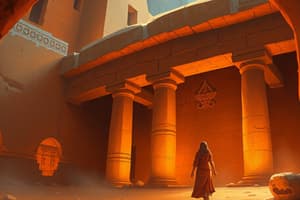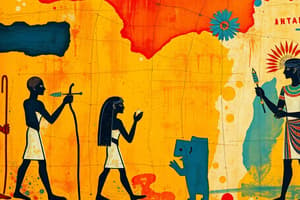Podcast
Questions and Answers
What is a defining characteristic of Roman art in terms of its style?
What is a defining characteristic of Roman art in terms of its style?
- Development of entirely religious themes
- Focus on portraiture and realistic individual likeness (correct)
- Use of geometric patterns and shapes
- Emphasis on abstract concepts and ideals
Which architectural innovation is a hallmark of Roman engineering?
Which architectural innovation is a hallmark of Roman engineering?
- The flying buttress
- The barrel vault
- The keystone arch (correct)
- The pointed arch
What was one of the primary purposes of Roman art?
What was one of the primary purposes of Roman art?
- To solely focus on religious narratives
- To promote public debates and discussions
- To inspire individual creativity among artists
- To convey power and commemorate achievements (correct)
Which medium was commonly used by medieval artists?
Which medium was commonly used by medieval artists?
Which characteristic is distinct to the style of medieval art?
Which characteristic is distinct to the style of medieval art?
How did medieval art serve its primary purpose?
How did medieval art serve its primary purpose?
What media did Ukiyo-e artists primarily use?
What media did Ukiyo-e artists primarily use?
Which of the following best describes the style of Ukiyo-e?
Which of the following best describes the style of Ukiyo-e?
What role did Augustus play in Roman art?
What role did Augustus play in Roman art?
Why are many medieval artists anonymous?
Why are many medieval artists anonymous?
What aspect of nature does Chinese painting emphasize?
What aspect of nature does Chinese painting emphasize?
What technique is commonly used in Ukiyo-e to create color gradients?
What technique is commonly used in Ukiyo-e to create color gradients?
What was one of the primary purposes of ancient Egyptian artworks?
What was one of the primary purposes of ancient Egyptian artworks?
Which architect is known for designing the first large stone building in ancient Egypt?
Which architect is known for designing the first large stone building in ancient Egypt?
What characteristic is distinctly associated with Greek art?
What characteristic is distinctly associated with Greek art?
Which media was primarily used by Greek artists to achieve fine detail in sculpture?
Which media was primarily used by Greek artists to achieve fine detail in sculpture?
The style of Contrapposto in sculpture is meant to create what effect?
The style of Contrapposto in sculpture is meant to create what effect?
What aspect of Roman art emphasized realism and everyday life?
What aspect of Roman art emphasized realism and everyday life?
Which significant artist is known for the statue of Zeus at Olympia?
Which significant artist is known for the statue of Zeus at Olympia?
Which form of media did Roman artists use for decorative flooring?
Which form of media did Roman artists use for decorative flooring?
What was the primary purpose of cave art in ancient times?
What was the primary purpose of cave art in ancient times?
Which characteristic is NOT associated with Egyptian art?
Which characteristic is NOT associated with Egyptian art?
What significant effect did cave art have on early humans according to the characteristics provided?
What significant effect did cave art have on early humans according to the characteristics provided?
In which period did Egyptian art flourish?
In which period did Egyptian art flourish?
How did the media used in cave art differ from that used in Egyptian art?
How did the media used in cave art differ from that used in Egyptian art?
What does the term 'hieratic scale' refer to in Egyptian art?
What does the term 'hieratic scale' refer to in Egyptian art?
What was a common media used by artists in both cave art and Egyptian art?
What was a common media used by artists in both cave art and Egyptian art?
Which of the following features is commonly found in cave art?
Which of the following features is commonly found in cave art?
Flashcards
Art Movement
Art Movement
A group of artworks sharing similar style, philosophy, and technique.
Ancient Art
Ancient Art
Art from early civilizations, spanning from prehistoric to classical antiquity.
Cave Art
Cave Art
Early human art, dating back ~40,000 years, often depicting animals and symbols.
Cave Art Media
Cave Art Media
Signup and view all the flashcards
Egyptian Art
Egyptian Art
Signup and view all the flashcards
Egyptian Art Media
Egyptian Art Media
Signup and view all the flashcards
Hieratic Scale
Hieratic Scale
Signup and view all the flashcards
Egyptian Art Symbolism
Egyptian Art Symbolism
Signup and view all the flashcards
Chinese Painting Media
Chinese Painting Media
Signup and view all the flashcards
Chinese Painting Styles
Chinese Painting Styles
Signup and view all the flashcards
Chinese Painting Purpose
Chinese Painting Purpose
Signup and view all the flashcards
Ukiyo-e Media
Ukiyo-e Media
Signup and view all the flashcards
Roman Art Focus
Roman Art Focus
Signup and view all the flashcards
Ukiyo-e Characteristics
Ukiyo-e Characteristics
Signup and view all the flashcards
Medieval Art Influence
Medieval Art Influence
Signup and view all the flashcards
Ukiyo-e, Edo Period
Ukiyo-e, Edo Period
Signup and view all the flashcards
Monastic Contributions
Monastic Contributions
Signup and view all the flashcards
Medieval Art Media
Medieval Art Media
Signup and view all the flashcards
Medieval Art Styles
Medieval Art Styles
Signup and view all the flashcards
Book of Kells
Book of Kells
Signup and view all the flashcards
Medieval Art Purpose
Medieval Art Purpose
Signup and view all the flashcards
Roman Art Purpose
Roman Art Purpose
Signup and view all the flashcards
Roman Artists Example
Roman Artists Example
Signup and view all the flashcards
Medieval Artists Example
Medieval Artists Example
Signup and view all the flashcards
Ancient Egyptian Art Purpose
Ancient Egyptian Art Purpose
Signup and view all the flashcards
Imhotep's Contribution
Imhotep's Contribution
Signup and view all the flashcards
Greek Art Key Characteristics
Greek Art Key Characteristics
Signup and view all the flashcards
Greek Art Media
Greek Art Media
Signup and view all the flashcards
Greek Art Purpose
Greek Art Purpose
Signup and view all the flashcards
Roman Art Realism
Roman Art Realism
Signup and view all the flashcards
Roman Art Media
Roman Art Media
Signup and view all the flashcards
Roman Art Characteristics
Roman Art Characteristics
Signup and view all the flashcards
Study Notes
Ancient Art
- Ancient art spans prehistoric times to classical antiquity, reflecting human expression and cultural values.
- Includes cave art, Egyptian art, and Greek and Roman art.
Cave Art
- Dates back ~40,000 years, marking the beginning of human art.
- Lascaux Cave in France displays animal, human, and abstract symbols.
- Artists used natural pigments (ochre, charcoal, minerals) mixed with animal fat or water.
- Styles include simple forms, silhouettes, and outlines, often depicting animals and geometric patterns.
- Purpose possibly related to hunting rituals and documenting events.
- Individual artists unknown, but works demonstrate collective effort of early humans.
Egyptian Art
- Flourished from 3000 BCE to 30 BCE, focused on the afterlife and honoring gods/pharaohs.
- Media: Stone, wood, metal, and papyrus (for sculptures, artifacts, decorative items, painting, writing).
- Styles include hieratic scale (larger figures = higher status), frontal poses, and symbolic colors (e.g., green for fertility).
- Purpose: Religious and funerary, artworks for temples, tombs, assisting deceased in afterlife.
- Imhotep, a major architect, designed the Pyramid of Djoser (first large stone building).
Greek Art
- (800 BCE to 30 BCE), influenced Western culture with emphasis on beauty, humanism, and idealized human forms.
- Media: Marble, bronze, pottery (e.g., black-figure and red-figure vases).
- Styles: Naturalism in sculpture, employing contrapposto (movement and balance in figures).
- Purpose: Celebrating human achievement, exploring mythology, honoring the gods, often for public spaces/temples.
- Significant artists include Phidias (Zeus statue) and Praxiteles (Aphrodite of Knidos).
Roman Art
- (500 BCE to 500 CE), adapted Greek influences, emphasizing realism and daily life.
- Media: Marble (sculptures), frescoes (wall paintings), mosaics (decorative flooring).
- Styles: Portraiture (capturing likeness), architectural innovations (e.g., arches and domes—Pantheon).
- Purpose: Conveying power, commemorating achievement, reflecting Roman values, and social status.
- Some notable figures (e.g., Augustus) contributed to artistic styles and the construction of major structures.
Medieval Art
- (500 to 1400 CE), primarily focused on religious themes, influenced by the church.
- Media: Illuminated manuscripts, stained glass, sculpture.
- Styles: Flat, symbolic representations, emphasis on outlines, bold colors over realistic proportions.
- Purpose: Religious education and inspiring devotion; conveying biblical stories and spiritual lessons.
- Monks created significant works like the Book of Kells and the Très Riches Heures.
Asian Art
- Reflects the continent's various religions, philosophies, and cultural heritage.
- Includes Chinese painting and Ukiyo-e (Japanese prints).
Chinese Painting
- Emphasizes harmony with nature and philosophical concepts.
- Traditional works use ink and brush on silk or paper.
- Styles include landscape painting and calligraphy.
- Purpose is to express spiritual and philosophical concepts, conveying essence of nature, beauty and transience of life.
Ukiyo-e (Japanese Prints)
- Celebrated everyday life, created through woodblock printing.
- Used vibrant colors, bold lines, perspective, and techniques like bokashi for color gradients.
- Subjects typically included landscapes, kabuki actors, beautiful people, and stories.
Studying That Suits You
Use AI to generate personalized quizzes and flashcards to suit your learning preferences.




